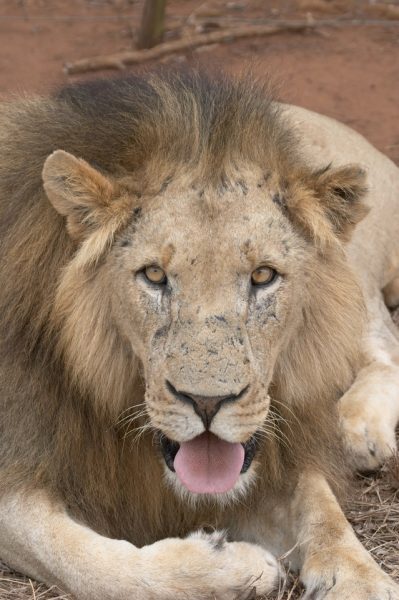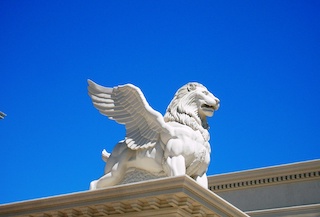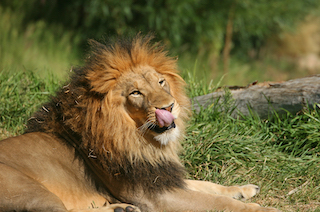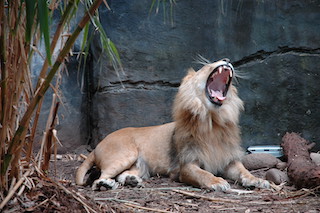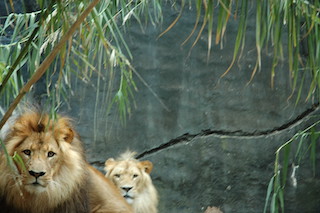Travel To Kenya To Get To Know The Lions
Distribution range
Travel to Kenya to get to know the lions. Lions occur across at an estimated 19% of Kenya including significant areas outside protected areas such as nature reserves and national parks. Interestingly, they don’t live in jungles but in scrubs, savannas, grasslands, woodlands and dense bush. These landscapes allow them to creep stealthily through vegetation and pounce on their unsuspecting prey. They can also be found taking a snooze in a tree or lying on their backs with the feet up.
Lions of Tsavo
Lions of Tsavo in Kenya are the most feared and fiercest predators in Africa. They are very elusive and the chance to view a pride of Tsavo lions is indeed a rare sight. Undoubtedly, they are the biggest draws of tourist attraction to Kenya. They are so ruthless and notorious that they stalled the Kenya-Uganda railway construction in the early part of the 20th century. There will only be 1 male in a pride of Tsavo lions. Unlike other male lions, a Tsavo male lion does not have a mane. You must travel to Kenya to get to know the lions.
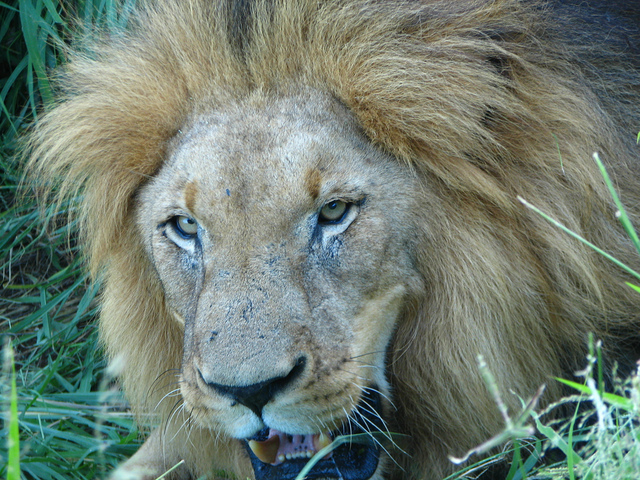
Travel to Kenya to get to know the lions
Eyes
Lions are born with blue-grey colour eyes, but it begins to change to an orangey brown when it is 3 months old. A mature lion’s eyes are quite big with round pupils. It cannot move its eyes from side to side, so have to turn its whole head when it wants to look in different directions. A white patch of fur situated below its eyes reflect light back into its eyes. The 2nd eyelid known as nictitating membrane protects the eyes and keeps them clean. All of these natural ocular features of lion make its eyesight 8 times stronger than that of a human being. To have a better understanding, it is rather important to travel to Kenya to get to know the lions.
Sense of smell
Scent glands of a lion are around its chin, lips, cheeks, tail, whiskers and in between toes. The glands produce an oily substance that keeps their fur healthy and waterproof. Also, lions have a small area called Jacobson’s organ at the roof of the mouth. It allows them to taste smells. They sniff the air using this gland to catch a scent to determine if it’s coming from someone worth eating. It is a funny scene to watch the lion do this. It curls up its top lip showing its teeth and sticks out its tongue, thus pulling a funny face.
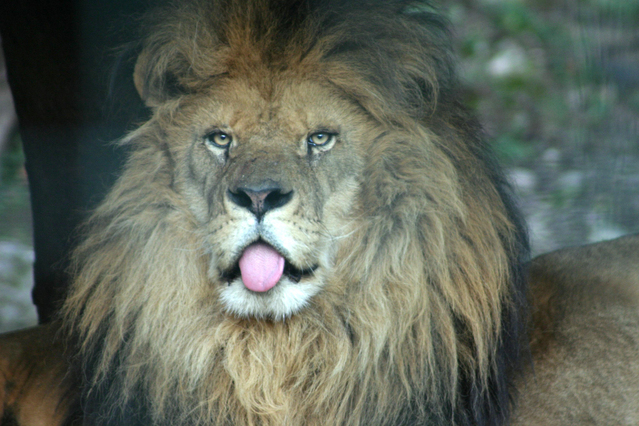
Travel to Kenya to get to know the lions
Tongue
Plan your next travel to Kenya to get to know the lions as well as to witness its tongue. In complete contrast to human’s, a lion’s tongue is so rough that if it licks the back of our hand only a few times, there would be no skin left. Lion’s tongue is pink, huge and covered with tiny spines called papillae. They face backward and can scrape dirt from fur, peel skin from flesh and even meat from bones.
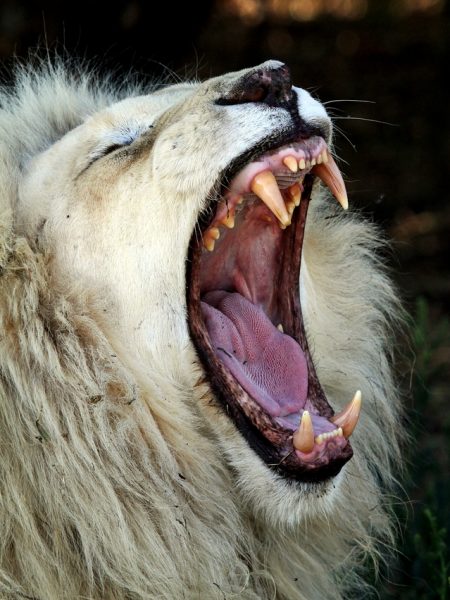
Travel to Kenya to get to know the lions
Teeth
Lions have 3 different kinds of teeth. Carnassial are the sharpest teeth situated at the back of the mouth and can act like scissors to cut meat. Canines are the 4 largest teeth that can reach up to 7 centimetres and are used to grip the skin. Incisors are the smallest at the front of the mouth that are used for ripping and tearing meat.
Whiskers
If you have not seen the whiskers of a lion, then very soon you must make plans to travel to Kenya to get to know the lions. All cats have whiskers, and lions are no exception. Whiskers are very sensitive hairs close to the nose that are used to feel the things around them. At the root of each of it is a black spot that collectively forms a pattern, which is different for each lion. Just like our fingerprints, researchers can tell them apart in the wild using their whiskers.
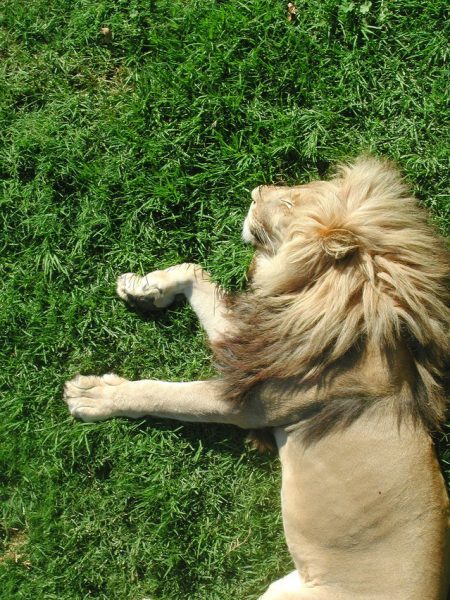
Travel to Kenya to get to know the lions
Paws
Lion’s paws have 5 toes in the front and 4 at the back. Its size can help determine its age and gender. It can deliver a fatal blow with the paws because it has the strongest forequarters which are bigger than hind legs. They have sharp, thick and strong claws that it retracts and hides under its fur when not in use to keep them protected. They can be up to 38 millimeters long and consist of lots of layers that gradually break off to reveal a sharper claw underneath. A 5th toe in front of the paw has a dewclaw that it uses to hold down the prey when eating. Lions sharpen their claws to keep them extra pointed by scratching trees.
Tails
Travel to Kenya to get to know the lions and look for any peculiarities in a lion’s tail. Use your binoculars for a closer look. Lion has a long tail that helps it to balance. At the end of the tail is a black tassel, which first appears when a cub is between 5 and 8 months old. Lion uses its tail to lead others through the long grass of savannas. A female lion will raise its tail to signal the cubs to follow and also to communicate with each other while hunting. When it is in a bad mood, it flicks its tail to warn others to stay away.
Tan coat
Lion has short hair that is tawny and paler underside. The color can vary from orange-brown, dark brown or tan. The proportion of dark hair to light hair in the coat determines the color. The beautiful tawny colored female cats blend in perfectly well with the vegetation of their surroundings, helping them to stalk the prey stealthily. Cubs are born with soft woolly pale brown or grayish-yellow coat variously marked with white spots on their back, legs, face and tummy and continue to have them for the first 5 months. The spots act as camouflage, blending them with the surroundings to make them invisible in bushes. It becomes thicker as the lion matures and the white spots gradually fade.
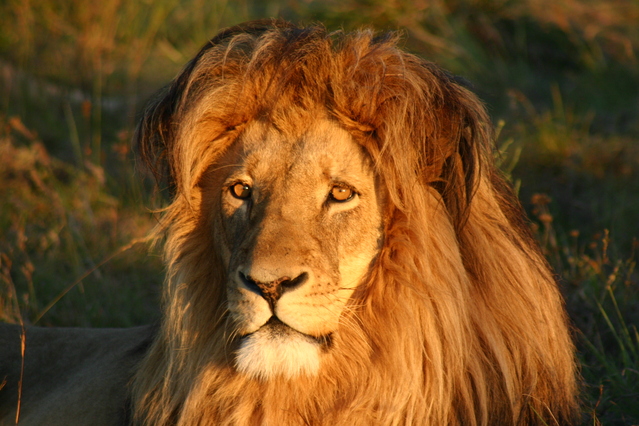
Travel to Kenya to get to know the lions
Mane of the man
Travel to Kenya to get to know the lions. Lion is the only cat family member in which males differ from females in appearance with its mane. No other cat has it. The thick mane which encircles the neck and head is the unique trait, distinctive characteristic and defined feature of a male lion. But it does not apply to young cubs where both genders look the same. Its only when they are 12 months old that the male lion begins to grow hair around its neck and chest. It continues to get longer and darker with age. Its length and darkness are affected by where it resides. Lions living in warmer places have lighter and shorter hairs than those in cooler regions. It can also change as it gets colder and hotter throughout the year. Nobody knows for certain why a male lion has a mane and not a female. Maybe it just serves as an ornamentation, akin to the showiness of a male peacock’s beautiful feathers. Researchers are still studying to understand why they have manes. So far, there are five theories as to why the males grow a mane. These are to protect the neck during fights, to keep cool and clean in hot climates, to blend in and camouflage, to sexually attract female lions and to intimidate other male lions.
1) Neck protection
A century or two ago, Charles Darwin theorised that lion’s mane acts as a shield to protect the neck during fights against other males. Over time, however, it was observed that when lions fought, they rarely went for the neck but attacked from the rear. So, the mane is not there to protect its neck.
2) Keep cool
Travel to Kenya to get to know the lions. Curiously enough, in the sweltering heat where lions gather, the bushy fringe does nothing to cool the body and in fact attracts parasites. Moreover, darker manes take a physical toll by raising body temperature. So, lion’s mane does not serve the purpose of a fan in warmer temperatures.
3) Blend in
In fact, mane makes the lion stand out like a sore thumb against the scenery. It does not even blend in well with the natural habitat where they live. So, the camouflage theory is out of the way.
4) Sexual attraction
Lion with a substantial mane means it has lived long enough to grow it. That implies it has some sturdy genes and healthy constitution. Over centuries, female lions subconsciously believe that a huge ring of impressive, thick and lush mane equals a virile daddy and an able guardian for its offspring. Thus, manes act as secondary sexual feature. Now, here is an interesting study to support that. The Serengeti lion project found out through experiments with dummy lions that females prefer male lions with darker manes. And the darker and thicker, the better. So, mane signals sexual maturity and health status to the females.
5) Peer intimidation
Lion’s mane is used not only to attract female lions but also to intimidate competing males. Its length, size, darkness, color and quality determine the lion’s overall fitness. A good brush of hair signals information to other rival males about a lion’s competence and fighting ability. It sends a message that such a lion is too strong to risk fighting for the pride control thereby reducing fights for dominance. Reduced fights increase survival rate as well as mating opportunities leading to more offspring. The ferocity of the mane can only be comprehended if one sees it physically in close proximity. That is why it is important to travel to Kenya to get to know the lions.
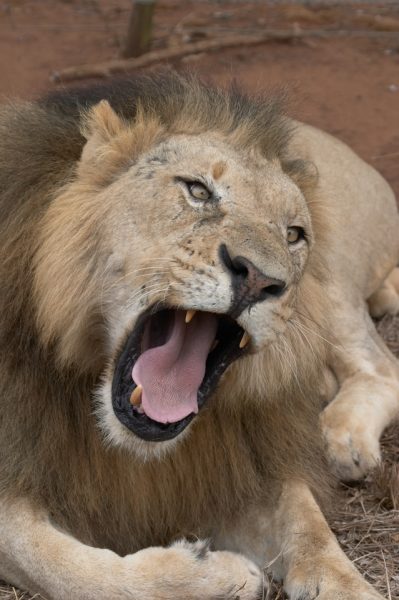
Travel to Kenya to get to know the lions
Roar
All adult members of a lion pride produce a unique vocalization that varies in intensity and pitch. They also make noises including woofing, meowing, purring, hissing and coughing. They keep track of each other, proclaim territory and rally straying pride members using such communication tactics. For interacting at close range, lions use a rich grunt. Both male and female lions roar. They can be heard most often just before dawn. To hear a lion roaring is an unforgettable experience as the sound emanates power. This archetypal roar of a lion is so loud and powerful that it can even be heard from a distance of up to 8km away and is as noisy as up to 114 decibels, about 20 times louder than a lawn mower that is gas-powered. It looks somewhat comical when roaring because it appears as if it is doing it with extreme difficulty to get the sound out, and when it finally does, there is a sigh of relief. While hunting, lion does not roar as this can warn the prey of its presence.
Inner workings of a roar
For those who are interested in the inner workings of a lion’s rumble, published research and studies shed some light on it. The secret is in the lion’s vocal cords. In most animals, the vocal cords are triangle-shaped and protrude into the airway. But in lions, the protrusions are shaped like squares because of the fat in the vocal cord ligament. This square shape allows the tissue to respond efficiently to passing air, allowing the roar to be louder with less lung pressure. The studies also suggest that there is a similarity between a baby’s cry and a lion’s roar. Both have vocal cords that are gel-like and are very loose that make irregular vibrations to create sounds and draw our attention. When you hear the roar of a lion in TV or in big screen, it does not even do partial justice. You need to hear it live. That is you need to travel to Kenya to get to know the lions.
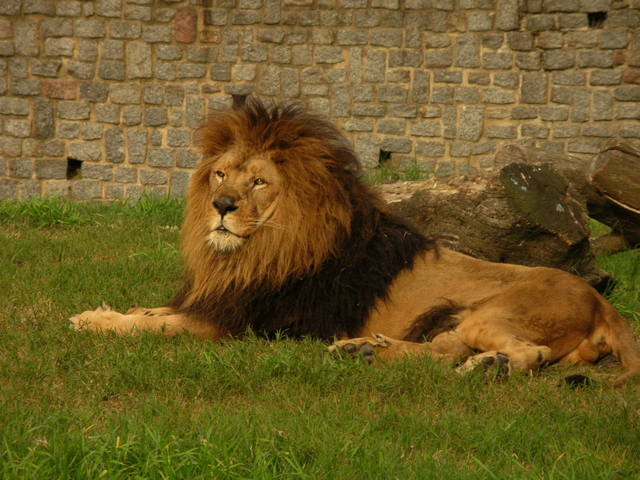 Male lions
Male lions
Male cubs become capable hunters from the age of 2. At this age, they are large enough to compete with alpha males. So, they are driven or thrown out of their natal pride by the leaders. Since the bachelor male lions are forced to fend for themselves and have no training in hunting, they often scavenge prey from predators like cheetah and leopard. The young boys eventually form bachelor groups with their brothers or cousins and follow other migrating herds living as nomads until they feel strong enough. Being in a group gives them the benefit of working towards a common goal of challenging the resident male of pride. Male lion is much heavier and larger than a female. The heaviest recorded one was 272kg from Kenya. Within the pride, males are the leaders and fathers of the cubs. They guard, patrol, protect, defend and maintain the boundaries of the pride’s territory, which can be up to 260sq.km. Male lions can go to great pains to mark their parcel of land. They do it by roaring, chasing off intruders, leaving scuff marks and marking it with urine.
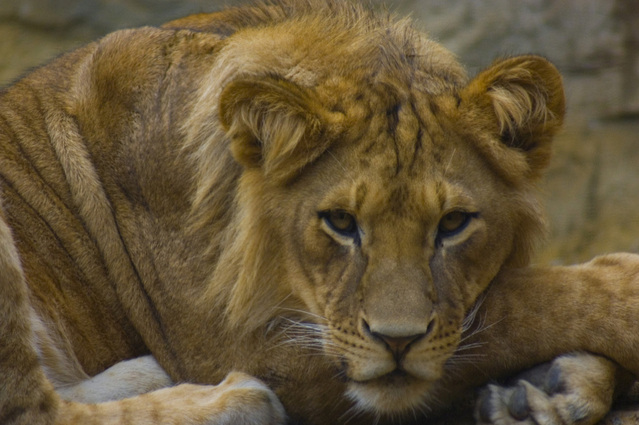 Female lions
Female lions
A female lion is called lioness. They are more agile and smaller than males. They primarily do the hunting and take care of the offspring. Female lions stay put and remain in the pride for their whole lives. Thus, all of the female pride members are usually related to each other. They start going on hunting excursions with elder female lions at the age of 2. If they were already pregnant when a new male takes over a pride, they can mate and easily pretend as if the cubs belong to the new male. Subsequently, the men end up with children that are not theirs. Travel to Kenya to get to know the lions and learn to distinguish between a male and female lion.
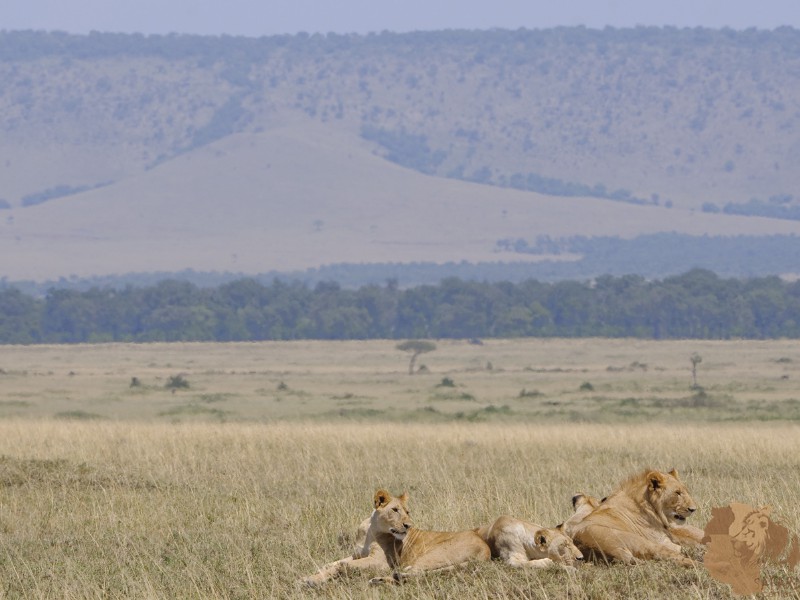 Pride
Pride
Most cat species live a solitary existence, but lions are exceptions. They are fundamentally social animals that tend to live in groups. A group of lions is called pride. Prides form extended but close family units following a matriarchal social system based on division of labor. Each pride controls a particular territory. Generally, a pride consists of up to 20 to 30 members including 1 to 4 males, 5 to 10 females and their young. The size becomes smaller if resources are scarce. Female and male lions have different responsibilities within the pride. Lionesses make up 75% of the pride, and they usually form life-long bonds. Territorial males stay in power in the pride for not more than 3 years before either a challenging bachelor group takes it over or new lions chase him away.
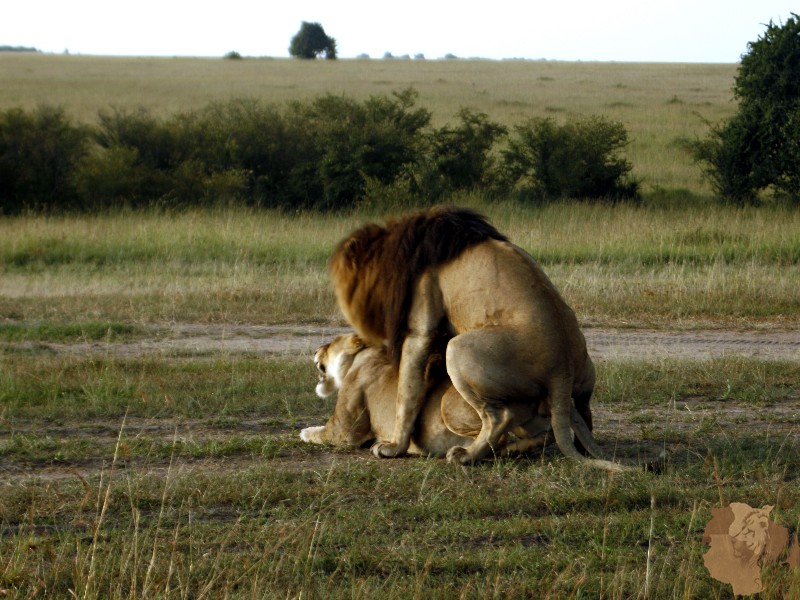 Mating
Mating
Leaders earn the right to mate female members of the pride. Both male and female lions are ready to mate at 3 or 4 years old. Lionesses come into estrous at the age of 3. Male lion checks the heat of a lioness by sniffing her reproductive organs. Then he stays with her constantly. They usually mate every 20 minutes for less than a minute over a period of 5 days. Lions have spikes on their penises which are supposed to cause trauma to the vagina and trigger ovulation. Female may turn to one of the other males in the pride when the first bloke is worn out. Sometimes female lion will have sex with an unfamiliar male lion from outside her pride, and this may cause a fight between males of the 2 groups. If she doesn’t conceive, then she goes back into oestrus after 2 weeks, and this continues throughout the year. Travel to Kenya to get to know the lions and to see how they mate. Lions mate about 50 times a day.
Giving birth
Lionesses give birth starting from the age of 4. A female won’t get pregnant until 2 years after her last delivery. At the end of gestation period, which lasts for 105 days, the female goes to an isolated area and gives birth to 2 to 4 cubs at a time. The cubs weigh about 3 pounds each. They are born completely helpless and can only open their eyes after about 10 days and start walking after 15 days. Cubs are extremely playful but are hidden away from the rest of the pride for several weeks by the mother either in a cave or dense cover. When they are 1 to 2 months old, the mom introduces them to the rest of the pride. Usually, 2 or more lionesses in the group give birth synchronically. Cubs have the best bet of survival when several of them are born almost simultaneously because the grown-ups can raise all their offspring in a nursery. That way, moms can go out and hunt while other mothers babysit and raise each other’s cubs communally. A female will permit the young other than her own to suckle. They nurse them for the first 10 months after birth. Cubs depend on their mothers until they are 16 months old. Females continue to give birth every 2 years and carefully nurture the young when food is in abundance. If not, they may neglect or abandon them. And there end the duties of a lioness.
Prey
When you travel to Kenya to get to know the lions do not expect to see lions being chased by animals. Mostly, other animals get eaten by lions and not the other way around. Lions have almost no predators because they are at the top of food chain. Lions kill and eat almost all other animals that share their habitat. Hence, these strict carnivores have a wide variety of prey. Lions are expert scavengers too. They steal prey from other carnivores like wild dogs, hyenas, leopards or cheetahs. They eat almost anything found dead. For old males who are too old, scavenging may be their only way to survive. They swipe at the defending beasts, who refuse to become the lion’s next meal but would rather forfeit their kill. The other competitor is spotted hyena that often share the same prey as lion, and they fight for it. At times hyenas attack, kill and eat sick and old lions. This warfare goes beyond food as sometimes lion hunts hyenas, kills them and not eat their prey. Lions also dominate and promote fear in other fierce predators, such as leopards and cheetahs, so that they do not hunt the same time as lions. However, these predators sometimes kill lion cubs especially when the mothers are not watching. But a healthy adult lion has nothing to fear. Its loose belly skin allows it to be kicked by prey with no chance of injury.
Cuisine tastes
Bigger game means more food for lions. So, when conditions permit, a much larger game is hunted such as impalas, wildebeests, antelopes, buffaloes, young elephants, zebras, rhinos, hippos, crocodiles, wild dogs and giraffes. They particularly savor the large oryx antelope species. Common prey is in the range of 250 pounds. Lions hunt smaller prey such as mice, birds, hares, tortoises and lizards only when nothing bigger is available. Usually, the meal starts with entrails such as heart, kidney and liver. But this feral cat’s cuisine tastes vary widely. Some lions eat everything except stomach. Others show a very adamant preference for intestines. Some male lions eat the hindquarters while the females eat the entrails. The last part they touch is the head. It is very unusual for them to open the skull.
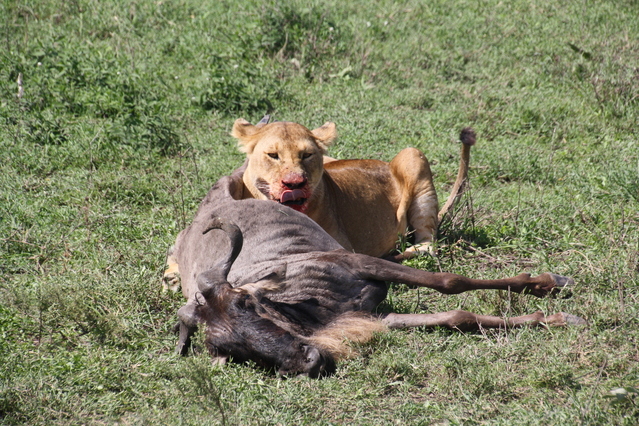 Hunting
Hunting
Lions only kill when they are hungry. Females do most of the hunting because a male lion’s prominent and conspicuous mane around its neck can be easily spotted by potential prey. However, males unfairly take the lion’s share, as the saying goes. The way lionesses hunt is fascinating and sometimes even sad to watch. It is certainly not an amusing sight to the animal lovers. Each lioness develops her unique role contributing to the success of killing the prey. Their best chance is when they stumble upon an unsuspecting victim who is caught by surprise. A lone lion finds it difficult to hunt because the prey they choose to kill is usually faster and nimbler. So, to increase their success rate, they hunt in groups using teamwork and smart tactics. Interestingly, they form hunting parties to attack prey whose hunting methods, techniques and skills are very scientific, ruthless, complex and precise. They work cooperatively to attack the prey by forming two groups. The 1stgroup consists of younger lions. Fanning out along a broad front or forming a semicircle, the smaller lionesses creep up and stalk the prey and herd it towards the center of the arc until they are ready to make the kill. The 2nd group consists of stronger females who wait in ambush. Travel to Kenya to get to know the lions. However, you would be the lucky few who can get to see a lion hunting.
Killing
Once within striking distance of at least 30 meters, the lionesses spring upon the prey, bite the neck or throat using their sharp teeth and needle-sharp claws and knock down the animal. The most frequently used method is suffocation by crushing its windpipe while biting the victim’s throat. If it is a large animal, the lion attacks at an oblique angle before throwing one paw over the shoulder. Then it uses its strength and weight to pull down the quarry. One of them in the group will clamp its mouth over the prey’s nose and mouth while others hold it down and open the abdomen. It is not unusual to see the team starting the meal even while the victim is struggling and alive, which often kills the animal quicker than the suffocation does. They kill up to 30 big animals annually. Because about two third of hunts are unsuccessful, lions may go on for days without eating. If the prey escapes before the attack, the lioness will not chase for long. This lack of endurance has given them a notorious reputation for being the laziest among the big cats. And the escaped animal, in most cases, would later die from lacerations inflicted by the deadly claws of lions. The king of jungle also hunts individually to bring down small game such as birds, reptiles and rabbits.
Digestive system
After the hard work of successfully hunting down an animal, the lions feast. They share the meal following a pecking order. Adult male makes the 1st claim. They are extremely aggressive, defensive and nasty when it comes to food. It arrives soon after the hunt and forces its way to the front, eating his fill until he is sated. When more than a male lion is at the kill, noise and aggression is the norm. Then comes the lionesses followed by cubs who are often left with scraps and leftovers after the adult lions have finished. Sometimes it results in fights. Lion’s fast-working digestive system allows them to gorge an average of 18kg in one sitting and go for a 2nd round shortly after. A good, full meal may result in 4 to 5 days of no activity and no desire to hunt. They will drink water every day if available, however, can go on for up to 4 to 5 days without drinking by obtaining moisture from the food contents in the stomach.
Lounging
After a sumptuous meal, the pride spends the whole day digesting its food. They have few sweat glands. Hence, they wisely conserve their energy by taking it easy during the day and becoming active during the night when it is cooler. They can be seen lounging, resting, relaxing and sleeping under acacia trees the entire day. When it is hot, they may rest for about 16 to 20 hours a day.
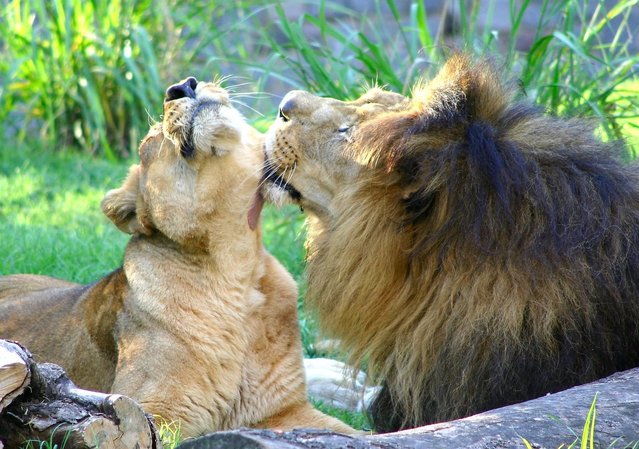 Socializing
Socializing
Lions socialize by being affectionate towards one another. During this time, they seem to enjoy good fellowship and camaraderie with lots of peaceful tactile actions such as grooming, touching, licking and purring. Lion possesses highly developed form of communication behaviors and animated movements. For example, rubbing heads is tantamount to shaking hands and roaring in chorus is a form of social communication. Territorial males are vocal, and the young ones are silent.
Survival tactics
Lion cubs have a mortality rate of 60-70% because they are vulnerable to predators like leopards, hyenas and black-backed jackals. Sometimes they get trampled by animals like buffaloes. Another factor that contributes to their high mortality rate is the fact that when male lions feel strong, they take over a pride and a fight ensues forcing weaker lions out in the battle until a winner is determined. Sometimes, it ends in death. Moreover, the victorious male usually kills all cubs fathered by the losing lion so that they can sire their own offspring. This is because female lions do not mate as long as they have cubs, but they will mate if the young ones are dead.She can come back into season within 4 weeks of losing her kids allowing them to become pregnant again. It is the male’s way of making sure that the females are available for procreation immediately. Otherwise, they may displace him before having his offspring. It also ensures that only alpha males remain in the pride thereby eliminating the weaker males. Sometimes during such fights, mother lions sadly get killed while trying to shield and protect their young.
Age
Lions are difficult to age. So, broad categories such as body size, nose color, coat condition and mane size are used to age a lion. Field researchers also consider various other features to estimate age correctly. Lion cubs up to 2 years can be aged accurately by comparing their height to the mother. When they are 1 year old, they reach only halfway up the mother’s shoulder. At 2 years old, female lions are about one quarter less the size of the mother. Males may sometimes develop the first signs of mane and can be bigger. A fully grown breeding adult lion is between the age of 3 and 8. At its prime age they often have large manes, dull fur, tattered and torn ears, broken and yellow teeth as well as scars. A lion normally lives for about 13 years.
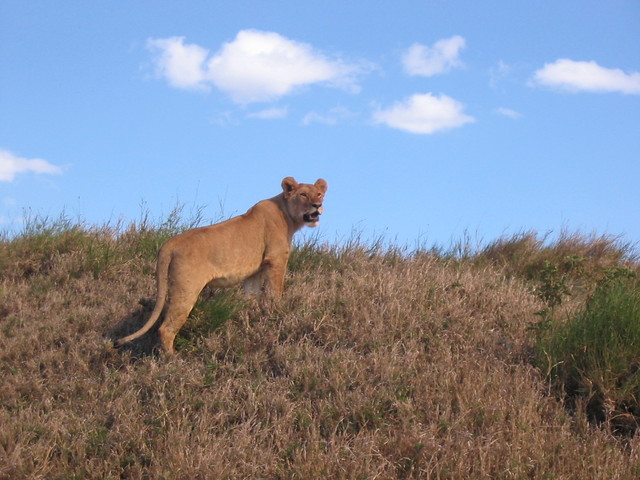 Culprits exposed
Culprits exposed
The reasons for the dramatic decline of lion population include, among other factors, hunting, poaching, climate change, loss of prey and increasing farming. Besides, lions are susceptible to tick-borne diseases such as canine distemper and babesia. They contract distemper by eating sick domestic dogs coming from neighboring villages as well as from hyenas. Babesia occurs when malnourished animals are vulnerable to disease during droughts. The combination of both these ailments has caused mass fatalities in lion populations. The factors that lead to reduction of lion population are not just diseases or nature related. Sadly, there are also human interventions that have contributed to the decreasing rate of lion population. Conflict is highest in areas where lions attack and eat the herders’ livestock. Moreover, droughts and loss of habitat have pushed lions closer to waterholes located near human settlement areas. That is when they come into conflict with local and urban population.
Maasai interference
Traditionally, Maasais killed lions as a reprisal for attacks on their livestock herd as well as part of a rite. Before the colonial period, Maasais considered lions to be a threat to their livestock. Hence, they used to kill lions at every opportunity to protect their cows. They slaughtered the animals upon encounter using shields and spears made out of buffalo hide. Furthermore, according to Maasai culture, for a teenage boy to claim his manhood, he must fight and kill a lion. Until then he is not considered a man. According to Maasai culture, killing a lion is considered to be the highest act of courage that wins prestige and praise for the hunter. But all that is changing. Today this custom has been outlawed through conservation laws.
Urban interference
Nairobi national park, established in 1946, sits on the edge of Nairobi bounded by an electric fence with skyscrapers in the background. The park is home to leopards, giraffes, buffaloes and other animals grazing in grasslands. Since its establishment, lion population there has grown more than tenfold. But lions in the park are under increasing pressure as the city is expanding on to traditional migration routes and hunting grounds. The park is losing its natural habitat due to increasing urbanization, intensive agriculture and lucrative development projects. The highway and railway which traverse one section of the park has agitated the cats with its constant noise. Hence, the survival of lions is at risk as they are coming into conflict with human beings. Rangers say lions pre-date people and are not straying into human settlements but is the other way around. People are trespassing into lions’ territory. While spotting lions on the loose are common in Nairobi, albeit the cases are few and far between, it is not so common for anyone to be injured by them. However, there have been some incidents of these cats sneaking out from south side of the park that is bordered by a river and straying into the city, even making its way into residential areas at night. The southern part is left open to allow wildlife migration that happens every year in search of new grazing land and water.
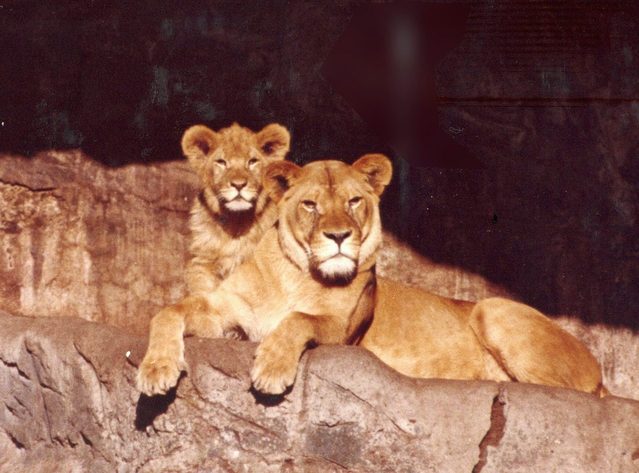 Conservation
Conservation
It is crucial to not interfere with the survival of lions because the importance of lions is immense not only to Kenya’s ecosystem but also to its tourism sector that contributes significantly to the economy. However, they are disappearing from the grasslands and savannahs of the country at an astonishingly rapid rate. Centuries ago, lions were the most ubiquitous land mammals after humans, but today its population is estimated to be a pitiful 20,000 in the wild. Out of that roughly only around 2,000 remain in Kenya, according to estimates from Kenya Wildlife Service. But the country is losing around 100 of them on an annual basis. IUCN red list considers lion as a vulnerable species. According to US Fish and wildlife service, over the coming 20 years, it is projected to lose 50% of its population. In the past 20 years, its population had already collapsed by 50%, although some put the decline rate considerably higher than this.
Lion conservation organizations
The dwindling figures of lions has put conservationists to work to find out the causes. Because of the alarming lion population decline rate, it is vital that Kenya Wildlife Service, in collaboration with local communities, implements conservation solutions. Some organizations and stakeholders have already created effective strategies to protect and coexist with lions. Thankfully, these conservation initiatives to facilitate a peaceful co-existence between humans and lions do bring in the desired results.
1) Born free
Traditionally, thorn barriers protected the livestock at night from lions, but these fences were ineffective in keeping a determined lion at bay. Therefore, herders retaliate by killing the lions at daybreak who eat their livestock. The organization called Born free has been implementing a program of constructing lion-proof bomas since 2010 aimed at reducing conflict with local communities. These bomas help keep lions away from livestock at night. It started off at some ranches adjacent to Amboseli national park and expanded from there. They are also exploring opportunities to promote lion-proof bomas more widely. In addition, the organization persuade Maasai warriors not to follow the culture of killing a lion to prove their prowess and strength. The organization also uses the movie Living with lions to develop a wider awareness of lion conservation. The film explains in Maasai language how other areas have been able to reduce lion-livestock conflict and how this could be replicated bringing significant benefits to local communities. This conservation effort with Maasais have been mostly efficient and have started producing phenomenal results.
2) Ewaso lions project
As the group fighting to ensure a future for lion population, Ewaso lions project promotes co-existence between wildlife and people using community-based outreach programs and scientific research to formulate strategies for lion conservation. It has collaborated with Born Free who supports them in their approaches which include mobile predator-proof bomas and various light systems within the bomas at night thereby protecting the livestock.
3) Partnership with KWS
Kenya wildlife service has partnered with Born free. All lion conservation actions correspond to priorities underlined by KWS. The strategic conservation work of conservationists at Kenya wildlife service includes fitting lions with radio collars and tracking them. Born Free and KWS, in 2016, conducted a survey to determine the size of lion population. The results form a baseline for monitoring its population as they continue to implement various actions.
4) Warrior watch
The Samburu tribe of Kenya has lived with lions for centuries, albeit not peacefully, and have protected their livestock from lions with brutal force. But one Samburu warrior is leading the fight from the opposite direction by saving these feral cats. Jeneria Lekilelei founded Warrior watch in 2010 with funding from National geographic to encourage his fellow tribespeople to conserve lions. Since then, lion population in Samburu has increased.
5) Lion guardians
In southern Kenya, some young Maasai warriors have swapped their role as lion-hunters to lion-protectors under a scheme. The organization behind the project is called Lion guardians. They have set up a camp in Selenkay reserve not far from Mount Kilimanjaro. This conservation system that takes advantage of age-old Maasai know-how and combines it with contemporary science also aims to help the Maasai community. Lion guardian warriors carry a GPS receiver. The location is sent to the camp once they find lions and a vehicle arrives at the site. The behavior of lion is then inventoried, photographed and studied. And it does not end there. Now, when a lion kills a cow, Maasai workers of the organization step in and dissuade cattle-owners from killing the lion. The work boosts their status within the community. The project has managed to increase local lion numbers fourfold. Selenkay scheme kicked off with just 5 people but has grown to more than fivefold.
6) US fish and wildlife service
The endangered species listing of lions helps the US fish and wildlife service to tackle hunting of lions. Although it will not ban the import of hunting trophies into the US, it will require permits that prove that they did the killing in a sustainable manner. Also, countries which allow hunting will have to show the Service agency that their programs enhance and protect wildlife populations before exporting any trophies into America. Apart from tackling illegal and unsustainable hunting, the agency has placed new restrictions on trade of lion bones and derivative products. For example, the medicine market in China threatens the survival of lion population. Their claws and bones are worn as pendants to increase the virility of the wearer. In this case, if anyone has violated wildlife laws by obtaining the lion derivatives through illegal means or in unsustainable manner, they will be barred from receiving future import permits for any wild animal.
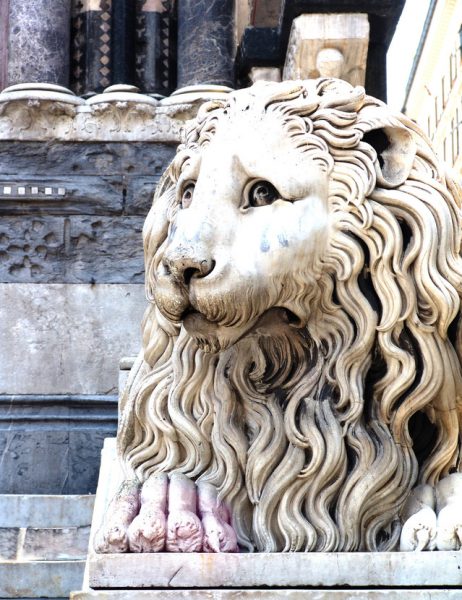 Lion symbolism
Lion symbolism
Since time immemorial people have drawn inferences regarding the characteristics, behavior and features of lion to use them in symbolism. Its symbolic meaning is very diverse. A male lion is a symbol of power and might, and the lioness is the mother and protector. In psychology, lion stands for latent passions in the unconscious and the risk of getting drowned in it. Lion parts carry different symbolism as well. Its carcass associates with honey, its head with care and vigilance and its tooth with eternity and indestructible.
Dual nature
Many interpretations emphasize lion’s dual nature. Despite the incidents of attacks on humans, it enjoys positive depiction as creatures that appear tough and gentle both at the same time. People describe leonine features such as powerful in protecting its own and stealth in attacking its prey. It is the embodiment of the Son of God as well as the force of evil. It has represented cruelty and savagery but also power and strength. Similarly, lion can be both lunar and solar.
Lunar and solar animal
Lion is primarily a nocturnal creature that hunts mostly during nighttime. In this, lion energy cloaks our spirit in the night. Hence, a lioness is a lunar animal since she is the one who does all the hunting. Throughout antiquity, the yellow color of lion’s mane symbolized it as a solar symbol. Therefore, lion comes roaring into the spiritual journey with all the raw power of the solar deities such as aggressiveness and courage. Hence, male lion is considered a solar animal. Being both lunar and solar animal, lion shares the world of both night and day. So, it bears a dual-natured symbolic message of prudence and balance as well as command and authority over subconscious thoughts. In other words, it asks us not to overdo but to keep an overall balance and an even mind in our life’s activities.
Soft nature
Lion spirit animal has a human-like soft side too. Ancient and modern stories give the king of jungle an additional meaning as kind and devoted to those who treat it justly. For example, we find in the story of Androcles that kindness to a lion is not soon forgotten. After Androcles helped it get rid of a thorn, the lion pays back by openly showing its affection towards him and refusing to eat the slave at the Circus Maximus. Similarly, in modern times, we witness the human nature of lion in Elsa the lioness. She is the most famous lion ever, written about in three bestselling books and featured in a motion picture titled Born Free winning two Academy awards. It is the incredible story of Elsa having a personal relationship with Joy and George Adamson.
Lion totem animal
If lion is your spirit animal, you have the power to reach and tap inside yourself the instincts, abilities and characteristics of lion and utilize them when you want to achieve goals. Choosing to invoke lion spirit as your totem animal symbolizes your readiness to tackle challenges head on or even assert or defend yourself. Walking with lion means being ready for trouble but not seeking it out. Channeling its energy assists you in understanding and recognizing your regal attitudes. It urges you to do what is right with conviction. The transmutation can be either positive or negative and a bit wild too. Use the lessons of lion wisely and with self-control. Don’t hesitate to use lion spirit’s energy from the grasses of your aura. Listen to the actions of lion for it will tell you if it is time to de-stress and relax your spirit, mind and body.
Lion spirit animal
When lion spirit animal presents itself, it comes with extraordinary vitality and strength. Lion is often attracted to people who are outspoken and brave with leadership potential. Subsequently, it appears in your life when you need to reclaim a space and take a leadership role. With a lion spirit at your side, you will learn about self-expression by banishing fear. The feline can also teach you how to handle your personal power efficiently and you will attract the spotlight with magnetism. When lion accompanies you, perhaps it is time to get involved in community responsibilities. Do not worry about the uncooperativeness of team. Lion is best for leaders dealing with such a group as it gives them the courage to make the necessary changes to organize cooperation among your peers. Spiritual leaders who have this spirit animal violently protect their faith and religious freedom. Remain humble with the lion because demeanor matters to lion.
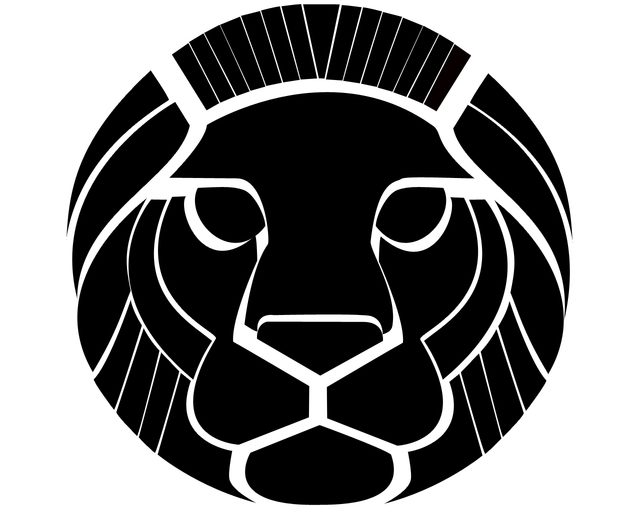 Earliest lion depictions
Earliest lion depictions
Lion’s earliest recorded depiction is in Paleolithic human cave art in the Chauvet Cave in southern France. In the carvings, lionesses are depicted hunting in much the same strategy as modern lions. Another better-known cave painting is that of Lascaux, where two lions are depicted mating. Vogelherd cave carving in southwestern Germany is from the Aurignacian culture.
Modern lion symbolism
With their stereotypical ferocious appearance yet a community driven spirit, sporting teams, countries and community centers alike use lions as metaphors. It is the symbol of income tax in Brazil. The 1966 and 2007 FIFA World cup contained lions as its mascot. In US, Fortitude and Patience are the stone lions outside New York public library. Ford Torino, Mercury Marquis, Ford LTD and Ford XL featured lion as the car emblem. In Australia, a heraldic lion is the logo of the car company Holden.
Lions international
On 7 June 1917, the delegates who congregated in Chicago chose the name Lions international for the new organization over several others because it stands for courage, strength, fidelity, liberty and intelligence. At the top is the word Lions and at the bottom International. The emblem has a gold letter L bordered by two lions facing away from the center symbolizing both future and past. It shows confidence in the future and pride in the heritage.
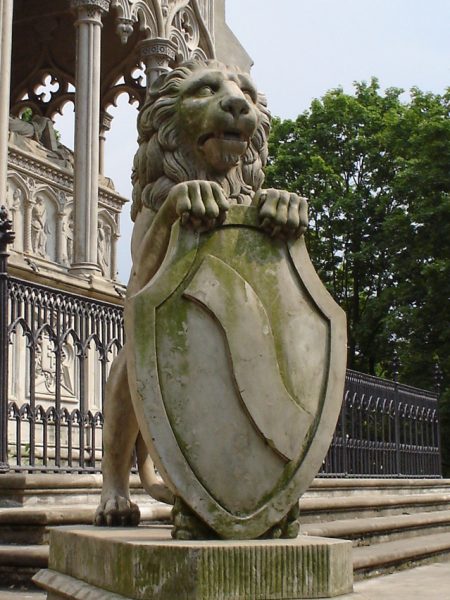 Lion cultural depictions
Lion cultural depictions
Lion cultural depictions are a global phenomenon that has been used for generations and over centuries. The diverse lion symbolism manifests itself in different forms in various cultures, traditions, religions and present-day entities who view it as majestic, regal, protector, father, warrior, leader, defender and soldier. They appear in tribal stories as a wise leader who leads with confidence. According to African tribal legends, the lion never shuts his eyes when it sleeps. Thus, it symbolizes cunning, strategy, intelligence, wariness, protection and careful watch. Lions are known for its stalwart fearlessness. It was viewed as vigilant guards. Hence, their flanking statues are in the entrances of great cities and doorways of buildings, temples, palaces, thrones and shrines. Lion was even considered protectors of the dead. Lion in Hinduism is an avatar of Vishnu and the pot-bellied lion is a symbol of blind greed. Most cultures use lion in a figurative sense. The same applies to nations. They also appear in some family crests and national flags. For example, the flag of Iran bore the sun and lion from 1946 to 1979. The coat of arms of Netherlands, United Kingdom, Bulgaria, Canada, Czechoslovakia, India, Spain, Kenya and Sweden has lion depiction.
1) Egypt
In ancient Egypt, lion was the brutal heat of sun. The Egyptian goddess Ra, who is the power that annihilates the wicked and protects the good, had the likeness of lion. Ancient Egyptians venerated lion as war god due to its power, strength and fierceness. In Egyptian culture, the famous sphinx has one of many mythical depictions of lion. Ancient Egyptian sphinx had a lioness’s body and head and shoulders of a human, which was a symbol of the goddess who shielded Pharaohs in afterlife. Later, they thought Pharaohs were the deity’s offspring and so ancient Egyptians depicted Pharaohs as sphinxes. The playful goddess of protection and dance appeared as having the head of a lioness instead of a domesticated cat. The fierce friend to children and women, Bast and Sekhmet’s son, Maahes, the war god, had lion likeness. Egyptians even portrayed Bast as a lioness. So did many other beings in Egyptian pantheon. Egyptian culture represents lion back to back facing west and east to track the sun’s movement across the sky, simultaneously symbolising tomorrow and yesterday, as well as rebirth and death.
2) England
Lion is shown in British heraldic art as a universal emblem of sovereign appearing either as puissant, rampant, curled up, standing or rearing on hind legs depicting traits such as bravery, honor, leadership and royalty. Some iconography separates lion symbol into two types. Lion with straight mane and longer body symbolizes fierceness, whereas the one with curly hair represents a timider nature.
3) Greece
Ancient Greek myth indicates that lions drew chariots for their gods and goddesses such as Artemis, Cybele, Dionysus and Phoebus. Greek myth links lion to Heracles, the solar hero, and his epic wrestling match with lion. In this context, the animal is death, killed by Heracles with his bare hands after which he wears its skin as armor.
4) Middle east
Middle Eastern art and stories show lion as high king. The goddesses and gods in this region had lion companions. Examples include Inanna who stands on the back of two female lions and Ishtar with a chariot that is lion-drawn alluding to the feline as an emblem of authority and strength.
5) Native American
For Hopi and Navajo tribes in North America, lion spirit is a sacred guardian whom they look for advice during rituals. They depict it as a hunter who is fearless and vigorous in the face of challenges.
6) Buddhism
Chinese Buddhists portray lion as a being of great majesty. They believe that lions safeguard humans from demons and ghosts. Therefore, their architecture includes lions standing guard at entryways. Buddha sits upon lion as a throne of wisdom and consistency. In one of the incarnations, Buddha looked like a lion.
7) Christianity
In Christian context, lion is a symbol of power of God or the open orifice of Satan. Moreover, Christianity represents the human and divine nature of Jesus through lion. The religion assigns front half of the lion to Christ’s divinity, and hindquarters to Christ’s humanity. Lion symbolism also deals with conversion and resurrection in Christianity. The meaning comes from the observation of lion cubs. People believed that the young of lions were born dead and that they come alive when the father lion passes its breath upon it. It was symbolic in Christianity as the father lion represented Jesus Christ and his breath represented the spirit flowing into children awakening their minds to God’s light.
8) Alchemy
As an alchemy symbol, lion takes on many representations. They give the symbolic lion the highly prized and idealistic attributes of gold as well as the untreated raw material. In alchemical texts, a green colored lion indicates matter which is the starting point of transformation. When illustrated in red, the alchemical lion means sulphur which speaks about eternal aspiration to reach enlightenment and the multiplicity of human nature.
9) Astrology
In astrology, lion indicates the zodiac sign of Leo. They are a proud lot and know their place in the world. They have a natural knack for leadership and commanding communication skills. Leo personalities can come on as very assertive. Interestingly, the assertiveness mellows in older age when they become more easy-going and playful. Those born under Leo are in control, fiercely independent and confident with a quiet demeanor. Most Leos tend to be influential and creative with the power to make positive changes in themselves as well as in the lives of others. Leos have a strong sense of community and gain a sense of identity within their group. Leo is a very loyal person and will defend family honor and friend to death.
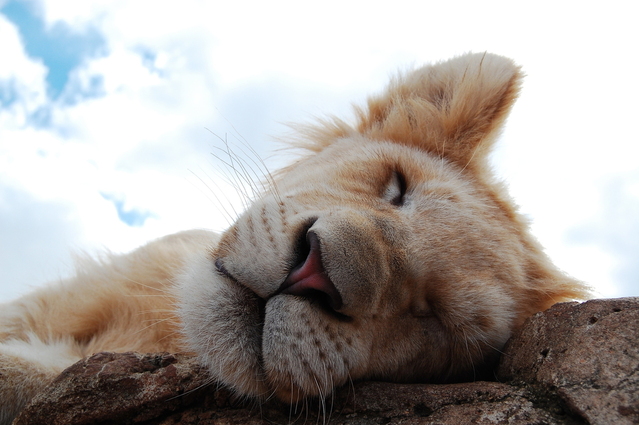 Dreams about lion
Dreams about lion
In the fantasy world, lion is the most persistent fighter in life’s challenges. Depending on the dream scenario, lion can represent several things. For example, to dream of a lion means having the ability to overcome some of your emotional issues by getting in touch with the feelings and taming them, if necessary. Also, in some cases but not all, lion can represent fertility. To see a lion in the jungle indicates the need to be more honest and loyal in your relationships. Some people dream of lions when they get a feeling of being preyed upon by enemies. Interestingly though, dreams of preying lion bring messages of self-sufficiency implying that you like to spend time alone because you are extremely independent.
1) Authority
Lion is the beast of beasts and symbolizes authority over others. Either it could represent your desire to hold power over people around you, or it could indicate someone has authority over you. Or it just reflects your inclination to dominate at work or in relationships. Also, spirit lion indicates the need to either be in control of the circumstances, or for you to control your aggressive impulses and temper. Be careful, though, not to become a control freak.
2) Defensive
To dream of a lion can symbolize a defensive position. You might have a dangerous condition that has entered your life. It represents predatory feelings deep inside you.
3) Strength
Symbolic lion spirit animal primarily deals with personal power and self-confidence. Lion in its habitat has a natural dignity and smooth power. The power comes naturally to a lion, and there is no false bravado because it is born powerful. Dreaming about lion is a reminder to step into our birthright of strength because each of us is born divine and powerful.
4) Lioness
Female lion signifies hope, motherhood, sensuality, stamina, tenacity and victory. Some cultures revere her as a sacred animal of goddess-mother and provider of her pride. Lioness spirit is attracted to people who protect and nurture the weak. She teaches you how to get your family working more cooperatively and how to care for your pride. It also teaches its young how to fend for themselves without leaving them vulnerable. Seeing a lioness in a dream means you fiercely protect those you love. It is also a signal never to give up and to keep going until you accomplish your goals.
5) Tamed lion
Dreaming of a tamed lion is a prompt to push you to change the way you do things because you have become too comfortable. It could be about your personal life or your old habits that no longer do you any good.
6) Black lion
A visit from black lion signifies negative energy. Someone is using their power or status to harm you and others.
7) White lion
When a white lion visits, it highlights your majestic power and you suddenly become aware of the power you hold. With this personal power, you can achieve anything when you draw on your courage, strength and wisdom.
8) Path-crossing lion
A lion will cross your path to strengthen your courage. It shows you when to walk your truth without fear, when to get involved and when to leave.
9) Threatening lion
Being scared in your dream denotes a sharp image of the emotional tension you feel inside. Most likely, a particular situation in your life is hard for you to comprehend at a conscious level. Thus, as a defense mechanism, you rejected it out of your awareness. Lion spirit animal appears to help. It is warning you that you are in the process of being aware of your life problems. It is your subconscious telling you to stop hiding behind closed doors and to examine what is causing tension despair. You now need to confront your issues and address them.
10) Chasing lion
The most common lion dream is being chased by a lion as you struggle to outmaneuver it which is next to impossible. When this happens, the lion spirit animal is trying to connect you to personal struggles and aspects in your life that you are trying to escape and showing you how to express them. For some people, it may indicate repressed feelings of aggression and anger towards someone who is mean to you.
11) Attacking lion
You are on a path of self-destruction. Dreaming of an attacking lion can mean someone, something or a force is driving you to self-destruction. There might be overwhelming circumstances in your waking life that are making it difficult to progress. You need to meet the challenges, overcome the obstacles and move on.
12) Biting lion
Bite from a lion is a negative sign. You are feeling overwhelmed, and the source of the worry could be about your feelings about a challenging situation. Lion that bites you brings warning to look at what is happening in your life. The image of a lion is an active call to say that it might be time to end toxic relationships after which your wounds can start to heal. Another interpretation is to check on what is dominating your life of late and to see if you can bring balance.
13) Killing lion
If you are under pressure to make significant decisions, you may encounter killing a lion in your dream. Take time to look closer and say no if you feel too pressured.
14) Dead lion
Ironically, it is a positive sign to dream of a dead lion. It can mean you can successfully meet serious challenges dealing with the law.
Caution
If lion keeps cracking through your awareness and dreams, it means your spirit animal is a lion. However, as with all symbols and signs, the symbolic meaning should be personal to each, meaning it is you who decide your unique and symbolic relationship with this animal. Although lion belongs to earth, its symbolism pertains to the spiritual world. One must understand it in that context. Any attempt to apply it in the physical world without spiritual stirrings would be foolhardy.
To receive a colourful digibook about lion with videos, images and text, please fill out the following form or simply email us on safaris@safari-center.com

